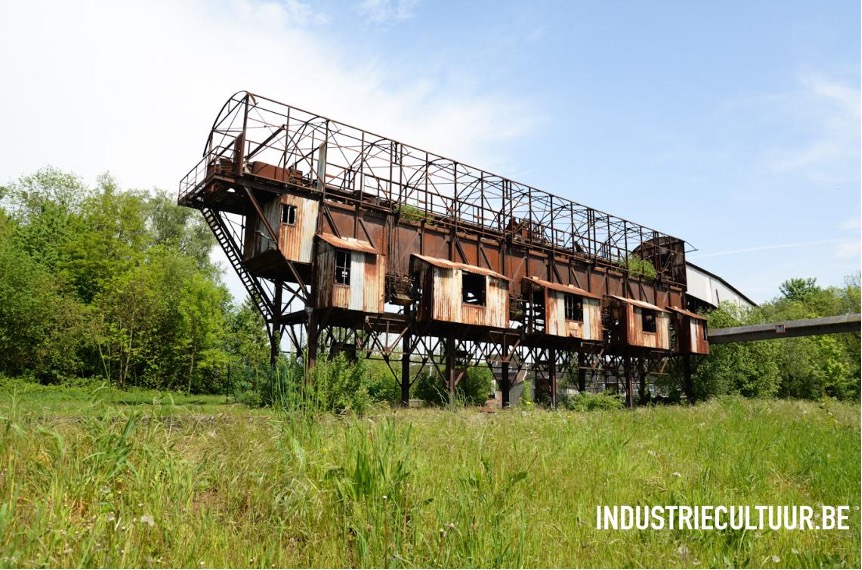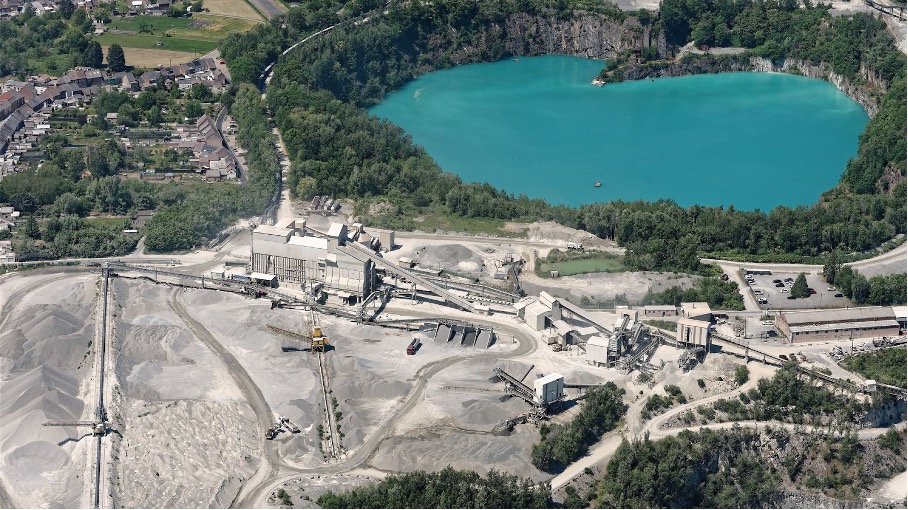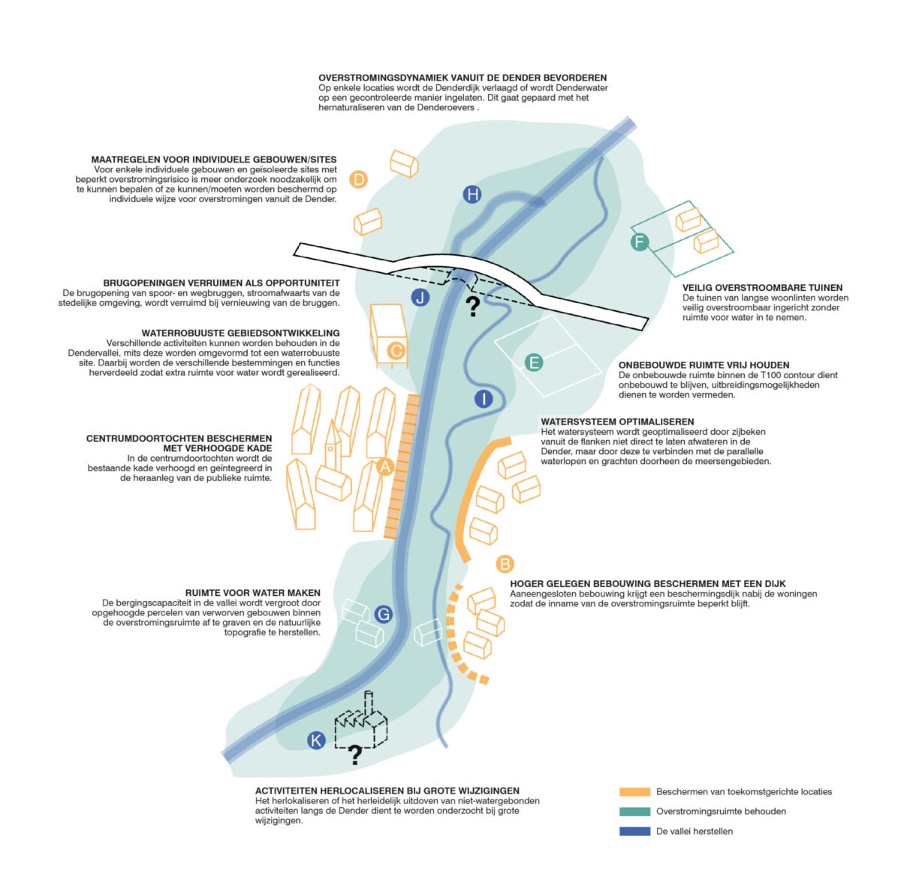By Luna Coesens
In the city of Lessines, located in Wallonia along the Dender River, industrial heritage and natural landscapes shape a cultural identity. Historically known for its porphyry quarries and industrial activities, Lessines is now caught between the need to preserve its industrial heritage and growing environmental challenges, such as flooding and land degradation. However, the city’s location near the border between Wallonia and Flanders exposes another issue: the disconnect in environmental and heritage policies between these two regions of Belgium. Wallonia, the French-speaking region of Belgium, and Flanders, the Dutch-speaking region, each have their own governments and distinct planning systems, leading to differing approaches in policy and regional development. While Flanders has been proactive in developing and implementing strategic plans for the Dender Valley in the last few years, nearby Walloon cities have not been considered in these plans. This disparity leaves cities like Lessines at a disadvantage, hindering their ability to preserve both their natural and industrial heritage. In this blog, I will explain how this policy gap could negatively impact Lessines, and how a more integrated, cross-regional approach could possibly help to address these challenges.
About this Blog
This is the 11th blog post of the series of 24 blogs prepared by graduate students and early career professionals who shared their views on the future of heritage and landscape planning.
The writers of these blogposts participated in the Heriland Blended Intensive Programme “Heritage and the Planning of Landscapes” in October 2024 in Gothenburg, Sweden.
The heritage of Lessines
Lessines’ industrial heritage is inseparable from its identity. The porphyry quarries, which date back to the 18th and 19th centuries, were once the main income of the region, providing employment for thousands of workers and contributing to the city’s growth. The quarrying industry not only shaped the economy, but also the physical landscape. Today, the remnants of this industrial past, such as the quarries and historical machinery like the “Truc” (a unique boat-loading device from 1922), stand as monuments to the city’s history.

Yet, as quarrying still continues, some sites were abandoned. Here, nature began reclaiming these industrial landscapes. Some of the former quarries have now become biodiversity hotspots, with rare species of orchids and other flora thriving in these ecologically unique environments. This dual character of industrial and natural landscape makes Lessines a special case in the Dender Valley, one that requires a mindful approach to both heritage and environmental management. One quarry has been flooded and is now one used by a diving club. There had also been a plan to turn the big quarry into Europe’s largest indoor ski facility, which would have had a big impact on the city, but this was later scrapped. These examples show the diverse potential uses for these former industrial sites.

The policy disconnect
In Flanders, the Dender Valley has been the subject of extensive environmental planning through the “Ruimte voor Water Dendervallei” (Space for Water Dender Valley) initiative. This strategic plan, launched in 2017, aims to manage flood risks, enhance biodiversity, and balance the needs of agriculture, tourism, and urban development. The Flemish government has taken a proactive approach to flood management, recognizing the risks posed by climate change and the need for long-term water management strategies. The plan includes the restoration of natural floodplains and the construction of infrastructure to mitigate flood risks. However, its water management strategies extend only as far as Geraardsbergen, the last Flemish city along the Dender River.
In contrast, nearby cities in Wallonia are not included in this strategy for the Dender Valley. The city of Lessines, despite being located along the same river bedding only a few kilometers away from Geraardsbergen and thus being prone to the same environmental risks as their Flemish counterparts, has not benefited from similar levels of planning. This policy disconnect leaves Lessines vulnerable, both in terms of flood risks and the preservation of its unique industrial heritage. The absence of coordinated policy efforts between the two regions exacerbates these challenges, as the natural and industrial landscapes do not adhere to regional boundaries.
A heritage-based approach
To address these challenges, a heritage-based approach offers a promising framework. By leveraging the historical and cultural significance of Lessines’ industrial sites, this approach can bridge the gap between environmental sustainability and heritage preservation. As noted by heritage scholar David Lowenthal, heritage is not merely about preserving the past but about “shaping the future” by connecting historical narratives to contemporary needs (Lowenthal, 1985). In Lessines, the industrial heritage of the quarries and the natural restoration of these sites offer a unique opportunity to create a landscape that balances ecological, cultural, and economic aspects.
A heritage-based approach would prioritize the preservation of industrial landmarks like the porphyry quarries, not just for their historical value but also for their potential to support biodiversity and sustainable development. Former quarries, now reclaimed by nature, could serve as ecological reserves that both protect endangered species and provide green space. Moreover, the adaptive reuse of industrial buildings could create new economic opportunities, such as cultural tourism or environmental education centers.

Cross-border collaboration
To fully realize the potential of this heritage-based approach, cross-border collaboration between Flanders and Wallonia is essential. The Dender River does not respect regional boundaries, and neither do the environmental challenges that affect cities along its banks. A coordinated policy effort, similar to Flanders’ “Ruimte voor Water” initiative, is needed in Wallonia to manage flood risks and preserve heritage in a way that aligns with sustainable development goals.
Such collaboration could take the form of joint environmental planning that integrates both regions’ needs, as well as heritage management frameworks that recognize the industrial significance of cities like Lessines. By working together, Flanders and Wallonia can ensure that the natural and industrial landscapes of the Dender Valley are protected, not just as isolated regional concerns, but as a unified effort to safeguard shared heritage.
Bridging the gap
The case of Lessines illustrates the broader challenges posed by regional policy disconnects in Belgium. Without coordinated efforts between Flanders and Wallonia, cities like Lessines remain at risk of losing both their industrial heritage and their natural landscapes. However, a heritage-based approach that emphasizes cross-border collaboration could offer a way forward. By integrating historical preservation with environmental sustainability, Lessines could not only protect its past but also build a more resilient future.
As scholar Laurajane Smith argues, heritage is inherently a process of negotiation, where different interests—historical, environmental, and economic—must be balanced (Smith, 2006). In the case of Lessines, finding this balance will require policy makers in both Flanders and Wallonia to work together. Through cooperative strategies, the Dender Valley and Lessines may be able to preserve their industrial and natural heritage for future generations.
In conclusion, finding common ground between the policies of Flanders and Wallonia is not only valuable for preserving the unique heritage of Lessines but could also help address the environmental issues. With a more collaborative approach, Lessines has the potential to become an example of how industrial heritage and environmental sustainability might coexist.
Bibliography
“Explorez un cratère terrestre à Lessines,” RTBF, July 29, 2023, accessed October 21, 2024, https://www.rtbf.be/article/une-opportunite-exceptionnelle-explorez-un-cratere-terrestre-a-lessines-11262650.
“Le Truc.” Industriecultuur, accessed October 21, 2024, https://www.industriecultuur.be/scheepvaart/le-truc.
Lowenthal, David. The Past is a Foreign Country. Cambridge: Cambridge University Press, 1985.
“Les Carrières de Lessines.” Action Nature asbl. Accessed October 21, 2024. https://www.actionnature.be/les-carrières-de-lessines/.
“Ruimte voor Water Dendervallei.” Accessed October 21, 2024. https://ruimtevoorwater.be.
Smith, Laurajane. Uses of Heritage. London: Routledge, 2006.
About the author
Luna Coesens is a master’s student in Heritage Studies at the University of Antwerp, Belgium. This Blog post is based on her own experience living in the Dender Valley and inspired by her participation in The Heriland Blended Intensive Programme “Heritage and Future Landscapes”, October 2024.
Contact Luna Coesens: luna.coesens@telenet.be
